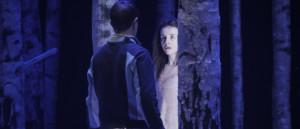Review: LET THE RIGHT ONE IN at THE ABBEY THEATRE

"Intriguing", "interesting" and "different" were the three words heard amongst the audience members as the lights of the Abbey theatre went on and the curtain of Let the Right One In came underwhelmingly down. These words can be excellent responses to be sure, but not when they come at the expense of terms such as "exciting" or "well-executed". Director John Tiffany's much-hyped and widely advertised production incorporated a lot of elements and took a lot of risks, while some worked not all panned out, leaving the play inconsistent in tone and style.
Let the Right One In is based on the bestselling Swedish novel of the same name by John Ajvide Lindqvist it has since been adapted into critically-acclaimed Swedish film and a well-received American remake. The source material is fast finding pride of place in the contemporary canon of vampire fiction. The widely respected and well-established story, therefore, presents some rather large vampiric boots for any stage production to fill. Here, while this play makes a valiant effort, it does, unfortunately, fall short of the mark in more than one place.
The highlight of this show is undoubtedly Christine Jones' stunning set design. The stage is populated by looming birch trees, a single lamp-post, and an intentionally downtrodden children's climbing frame. A light dusting of snow covers the ground and a fabulously eerie tone is established from the offset. This visual sets the tone for the eerie, Nordic noir subtlety and gothic ambiguity of the story's cinematic and literary predecessors. This potential remains hinted at but sadly unfulfilled throughout the play.
The cast provides good performances. Craig Connolly is believable and charmingly understated in his portrayal of the troubled and childlike Oskar. Bob Kelly and Richard Clements fill out a strong supporting cast presenting intriguing opposing father figures for the waif-like Oskar.
As is unavoidably the case in any and all vampire fiction, the validity of the narrative rests heavily, almost entirely, on the supernatural shoulders of that all-too-familiar undead figure. Key contributor to studies of vampire fiction Jeffrey Weinstock, suggests that vampire texts are by their very nature intertextual, we cannot simply watch a vampire film or read a vampire book without the weight of the ever-growing canon of vampire fiction defining our interpretation of each individual text. The Abbey's foray into the world of the vampire did not hold up under this pressure. Given the impossible task of carrying the intrigue, excitement and suspense of the entire show, Katie Honan's performance is good, it is simply not good enough. The apparent danger she presents is unconvincing as is her supposedly irresistible allure.
This downfall cannot be wholly attributed to Honan's performance, much of it is due to the script. In an attempt to be minimalist and mysterious exposition is overly ambiguous at times when clarity is essential for anyone who has not read the book. At other times the dialogue can be painfully on the nose. The repeatedly foregrounded omission of the v-word is obtuse in its comparison to its stylish achievement in its cinematic precursors.
There are times when dialogue is disregarded in favour of interpretive dance sequences and all-encompassing music and lighting displays. These worked very well and had they received more attention than the often clunky dialogue the atmosphere of the play would have benefited immensely. As it stands, with these musical and dance interludes present but decentred, they felt jarring, even disruptive at times.
The depiction of violence was executed brilliantly. It would have been very easy to overload the stage with blood or even to veer in the opposite direction in stylisation and omit the blood. Both ventures would have been disastrously remiss and as such were thankfully avoided. The vampire's murderous actions were showcased but not overstated and the blood-flow was just enough to shock without entering Tarantino levels of carnage. The violent set-pieces were always well-motivated by the narrative and therefore never felt superfluous.
Ultimately, with not one but two other adaptations to compete with, this stage production had a massive amount of work cut out for itself, and it failed to meet the high standard set by previous iterations of it stunning and rapidly becoming iconic source material. This show reaches for a very high bar and falls just short but must be admired for its strong effort.
Comments
Join Team BroadwayWorld
Are you an avid theatergoer? We're looking for people like you to share your thoughts and insights with our readers. Team BroadwayWorld members get access to shows to review, conduct interviews with artists, and the opportunity to meet and network with fellow theatre lovers and arts workers.
Interested? Learn more here.
.png)
|
.png)
|
Videos

